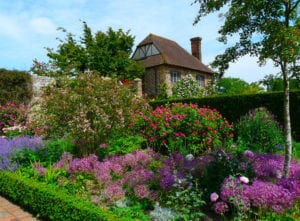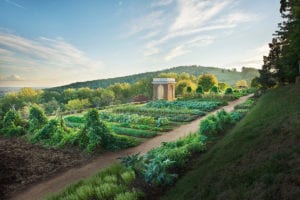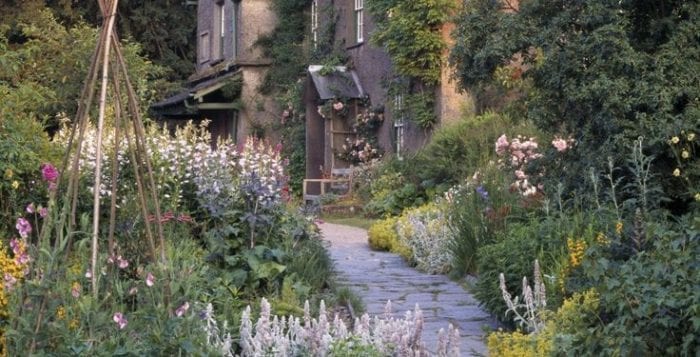By JoAnn Canino
Documenting your garden by keeping a garden journal not only creates a complete record but also allows you to make informed decisions to improve your garden from season to season. Now is a good time to start a garden journal. It is a way of extending the joy we get from our gardens well into the winter months.
Keeping a journal can be as simple as making notations in a notebook as you make your daily rounds in the garden. I use a lined composition notebook for observations and an unlined sketchbook to make drawings. To organize my notes, sketches and research I use a loose-leaf binder divided into sections. Setting up the binder, include a pocket to save plant tags, seed packets and receipts. Use graph paper for sketching layouts of each bed.

Vita Sackville-West, a noted garden writer, and her husband, Harold Nelson, diplomat and journalist, designed the Sissinghurst Castle Garden in Kent, England. They suggested careful planning should begin with a detailed architectural drawing that includes plans for color and seasonal changes.
Make lists of plants you would like to try. Keep plant profiles: date planted, care instructions, watering and fertilizing schedules. Include sketches and photos. For the kitchen garden, keep a plant and seed tracker. Include seed sources, date planted and germination date. Note success rate and expected harvest yield. Details can be recorded in your notebook then transferred to index cards for easy reference. Track the weather from season to season: Note dates of frost this year as compared to last year. How many inches of rain actually fell? How many days of sunshine? Remember to add photos to document the changes.

Thomas Jefferson, president, architect, scientist and gardener, kept detailed notes of his observations and activities in his “Garden Kalender.” He noted dates seeds were planted, harvest schedules and when the beds were manuered at his plantation in Monticello. His notes were as simple as, “Peas killed by frost. Oct. 23, 1809.” But Jefferson’s vegetable garden was set up for experimentation. He imported squashes and broccoli from Italy, beans and salsify collected by the Lewis and Clark expedition, figs from France and peppers from Mexico. Jefferson’s intention was to eliminate “inferior” varieties. “I am curious to select one or two of the best species or variety of every garden vegetable and to reject others from the garden to avoid the dangers of mixing and degeneracy,” he wrote.
Recording your experiences and observations will allow you to develop a greater awareness of the changes that occur from day to day and from season to season. Be open to discovery, use your senses to look closely at nature in your own backyard. Listen to sounds and look for patterns. Create a habitat for wintering wildlife. Put up a birdbath or a small pond. Plant native plants, mulch leaves and add bird feeders.

If you are exploring different garden themes, it is helpful to have a section in the binder for pictures of gardens that inspire you as well as articles and research on the typical needs of each design. For example, a formal garden with groomed hedges and a balanced symmetry would follow an Italianate design. Edith Wharton’s garden, The Mount, in Lenox, Massachusetts, follows this formal plan. Her gardens were a source of inspiration for her writing.
Beatrix Potter at Hill Top Farm in the Lake District, England, followed the philosophy of William Morris of the Arts and Crafts Movement, which celebrated fine craftsmanship. While she had a separate walled vegetable garden, her beds and borders were informal.
She mixed hardy flowers with bulbs and fruit shrubs. As an artist and naturalist, she made detailed studies of the plants and animals on her farm. Her much loved “Tales of Peter Rabbit” have entertained many readers. Illustrations for her books were painted in her garden.
Between 1883 and 1897, Potter studied and painted mushrooms and lichens. Her paper, “On the Germination of the Spores of Agaricinae,” was based on these studies. Consider how you are a part of the ecosystem and let your garden be your inspiration for writing, drawing and discovery.
Autumn tips for your garden
•Take time to observe where the sunlight falls now.
• Fill any gaps in borders with autumn flowering plants such as sedum, asters and chrysanthemums.
• Continue to feed and deadhead the hanging baskets to extend the color.
• As the weather cools, bring indoor plants back inside.
• Refresh the soil and repot to avoid bringing insects inside.
• Select flowering bulbs: tulips, narcissi, hyacinths, iris, allium and fritillaries to plant as temperatures cool.
• Cut hydrangea flowers for fall table designs and wreaths.
JoAnn Canino is an avid journal writer and gardener and a member of the Three Village Garden Club.





